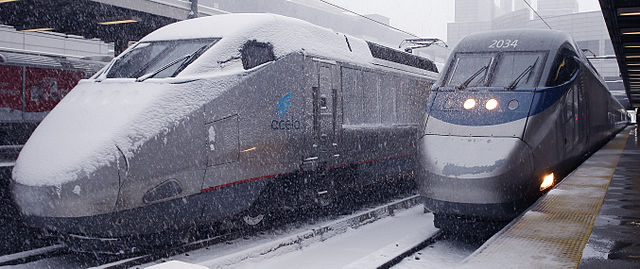Happening Now
Redefining What is Possible
December 16, 2013
Written By Colin Leach

Since the passage of the High Speed Ground Transportation Act in 1965, the federal government has consistently committed to investment in high speed rail services. So far, however, these attempts have been limited to trains that run on the same track as conventional trains in the Northeast Corridor. Whether the Metroliner in 1969 or the Acela Express in 2000, these trains’ performance has been limited by the constraints of track engineering. A winding right of way, combined with aging signals and electrical infrastructure, means that high-speed services are functionally limited to a top speed of 150 mph- and then, only on very small portions of the corridor.
Amtrak has long recognized that this is not sufficient. When other countries such as France, Germany, Japan, and China can successfully operate multiple high speed lines with average speeds exceeding 200 mph, there is no reason why the same could not be done here. And that’s why when Amtrak announced in January that it was making a joint search with California High Speed Rail for the next generation of high speed trains, the railroad requested bids for equipment that could operate at 220 mph. In setting this specification, Amtrak argued that it was building for the future. CEO Joe Boardman noted that buying 220 mph trains now gives the railroad “an ability to take advantage of higher speeds as the infrastructure is improved.”
Unfortunately, as is often the case with passenger rail, this goal has had to be postponed. Recently, Amtrak announced that itwas revising the initial 220 mph specification to a much less ambitious 160 mph. This decision was heavily criticized by many experts within the high speed rail community, such as Rod Diridon of the Mineta Transportation Institute. Diridon noted that most high speed trains elsewhere do operate at 220 mph or higher, leaving him confused as to what prompted Amtrak to change the specification.
The problem, as Amtrak spokesman Craig Schultz explained, is essentially political. 160 mph is the maximum operating speed that can be achieved on the existing line, even if “the most favorable of assumptions about funding availability for infrastructure improvements” are made. The engineering difficulties involved in reconfiguring the Corridor for 220 mph+ would require “tremendous investment”, and as such cannot be a short term goal.
However, this does not mean that Amtrak has abandoned its goal of faster trains; Schultz reiterated that Amtrak would “continue to work” towards it. FRA spokesman Michael Murray said that he was confident that the joint order with California could still proceed, noting that only “minor modifications” were required to account for the change in desired speed and that a train operating at 160 mph could be designed to allow for operation at higher speeds in the future.
Yet NARP will not be satisfied with political constraints imposed by the two-year election cycle. While Amtrak is doing the best it can with what it has, more must be done to build the passenger rail system that Americans want and deserve. And it’s not just a question of building 220 mph service in the Northeast Corridor. It’s also a matter of fighting for high speed rail between Los Angeles and San Francisco, and between Los Angeles and Las Vegas.. It’s about making sure that regional services in the Midwest survive in spite of weak state finances and grow to meet future demand. It’s about making sure that the long-distance trains not just remain in operation, but adding more capacity and more frequencies.
That’s what NARP is here to do. As the voice of passengers across the country, we advocate for a bold vision that addresses future demand as well as today’s needs. Naturally, we speak up for passenger rail when congressional opponents threaten to annihilate federal support for the service, as we did this past summer. But we also defend the need to make smart investments today to build the network of tomorrow, a vision we articulated in our recommendations for the upcoming passenger rail reauthorization.
The problems facing passenger rail, whether high speed or conventional, are fundamentally political. We know that our politicians happily commit funds to highways and airports; there’s no question of the massive subsidies directed towards these modes. Passenger rail needs faithful advocates who will address the myths about its viability and will defend it as an integral part of the nation’s transportation network.
You can be one of them. Join us in the fight for more and better train services.
"It is an honor to be recognized by the Rail Passengers Association for my efforts to strengthen and expand America’s passenger rail. Golden spikes were once used by railroads to mark the completion of important rail projects, so I am truly grateful to receive the Golden Spike Award as a way to mark the end of a career that I’ve spent fighting to invest in our country’s rail system. As Chair of the Transportation and Infrastructure Committee, it has been my priority to bolster funding for Amtrak, increase and expand routes, look to the future by supporting high-speed projects, and improve safety, culminating in $66 billion in new funding in the Bipartisan infrastructure Law."
Representative Peter DeFazio (OR-04)
March 30, 2022, on receiving the Association's Golden Spike Award for his years of dedication and commitment to passenger rail.
Comments